Chapter 7 - The Formation of a National Government
![Scene at the Signing of the Constitution of the United States by Howard Chandler Christy [Public Domain], via Wikimedia Commons; modified (crop)](https://www.oercommons.org/editor/images/7616)
Signing the constitution while others look on.
Total Video ( 00:18:63)
“Every man, and every body of men on Earth, possesses the right of self-government.” Drafter of the Declaration of Independence Thomas Jefferson, 1790
STATE CONSTITUTIONS
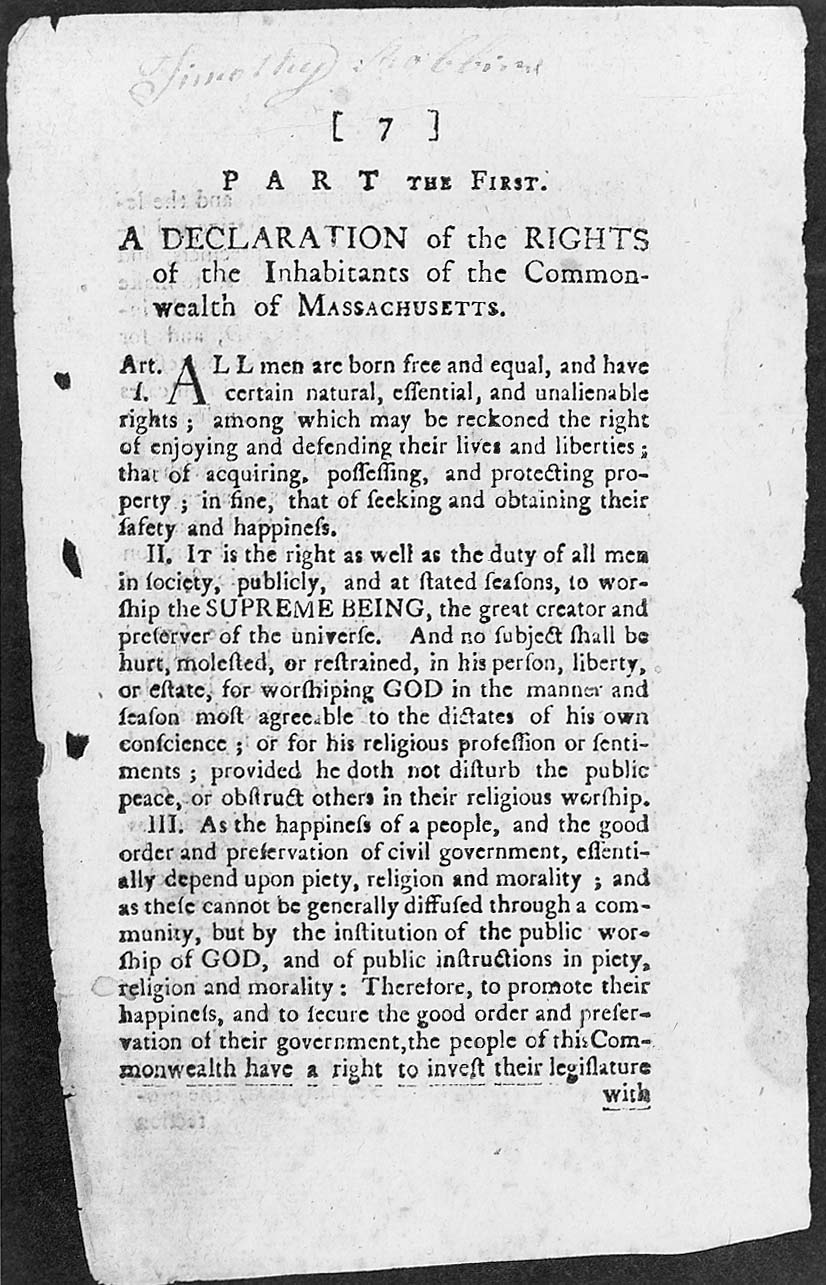
Image of the declaration of rights agreement.
The success of the Revolution gave Americans the opportunity to give legal form to their ideals as expressed in the Declaration of Independence, and to remedy some of their grievances through state constitutions. As early as May 10, 1776, Congress had passed a resolution advising the colonies to form new governments “such as shall best conduce to the happiness and safety of their constituents.” Some of them had already done so, and within a year after the Declaration of Independence, all but three had drawn up constitutions.
The new constitutions showed the impact of democratic ideas. None made any drastic break with the past, since all were built on the solid foundation of colonial experience and English practice. But each was also animated by the spirit of republicanism, an ideal that had long been praised by Enlightenment philosophers.
Naturally, the first objective of the framers of the state constitutions was to secure those “unalienable rights” whose violation had caused the former colonies to repudiate their connection with Britain. Thus, each constitution began with a declaration or bill of rights. Virginia’s, which served as a model for all the others, included a declaration of principles: popular sovereignty, rotation in office, freedom of elections, and an enumeration of fundamental liberties: moderate bail and humane punishment, speedy trial by jury, freedom of the press and of conscience, and the right of the majority to reform or alter the government.
Other states enlarged the list of liberties to freedom of speech, of assembly, and of petition. Their constitutions frequently included such provisions as the right to bear arms, to a writ of habeas corpus, to inviolability of domicile, and to equal protection under the law. Moreover, all prescribed a three-branch structure of government — executive, legislative, and judiciary — each checked and balanced by the others.
Pennsylvania’s constitution was the most radical. In that state, Philadelphia artisans, Scots-Irish frontiersmen, and German-speaking farmers had taken control. The provincial congress adopted a constitution that permitted every male taxpayer and his sons to vote, required rotation in office (no one could serve as a representative more than four years out of every seven), and set up a single-chamber legislature.
The state constitutions had some glaring limitations, particularly by more recent standards. Constitutions established to guarantee people their natural rights did not secure for everyone the most fundamental natural right — equality. The colonies south of Pennsylvania excluded their slave populations from their inalienable rights as human beings. Women had no political rights. No state went so far as to permit universal male suffrage, and even in those states that permitted all taxpayers to vote (Delaware, North Carolina, and Georgia, in addition to Pennsylvania), office-holders were required to own a certain amount of property.
THE ARTICLES OF CONFEDERATION
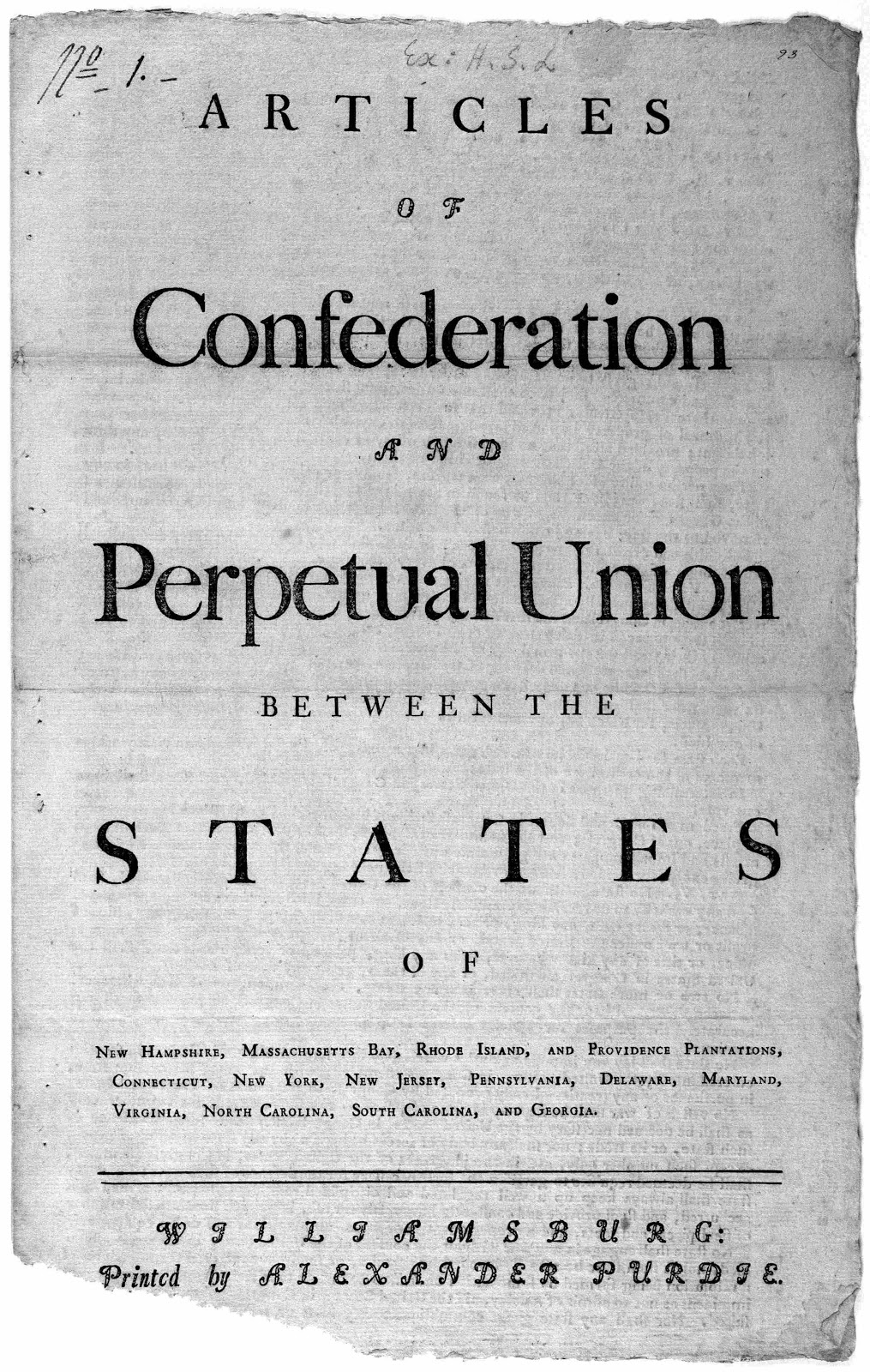
Image of the Articles of Confederation and Perpetual Union
The struggle with England had done much to change colonial attitudes. Local assemblies had rejected the Albany Plan of Union in 1754, refusing to surrender even the smallest part of their autonomy to any other body, even one they themselves had elected. But in the course of the Revolution, mutual aid had proved effective, and the fear of relinquishing individual authority had lessened to some degree.
John Dickinson produced the “Articles of Confederation and Perpetual Union” in 1776. The Continental Congress adopted them in November 1777, and they went into effect in 1781, having been ratified by all the states during the war. Reflecting the fragility of a nascent sense of nationhood, the Articles provided only for a very loose union. The national government lacked the authority to set up tariffs, to regulate commerce, and to levy taxes. It possessed scant control of international relations: A number of states had begun their own negotiations with foreign countries. Nine states had their own armies, several their own navies. In the absence of a sound common currency, the new nation conducted its commerce with a curious hodgepodge of coins and a bewildering variety of state and national paper bills, all fast depreciating in value.
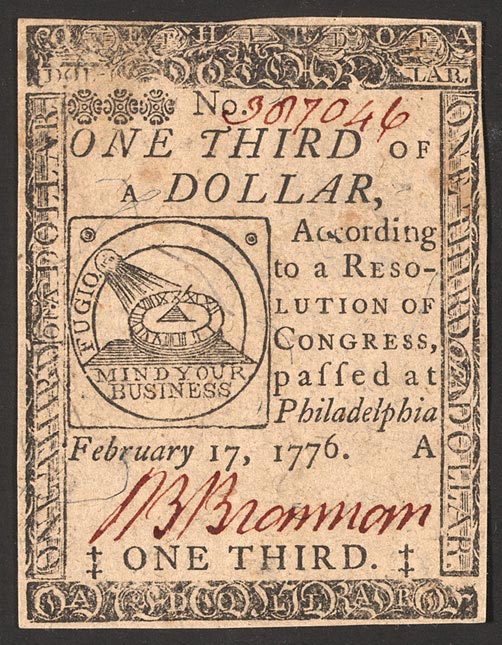
Image of Colonial Currency. 1/3 dollar dated February 17th, 1776
Video: (00:03:21) Articles of Confederation (https://login.proxy.nmc.edu/login?url=http://digital.films.com/play/7JEZQB) This video is accessible to NMC students only (login required).
Economic difficulties after the war prompted calls for change. The end of the war had a severe effect on merchants who supplied the armies of both sides and who had lost the advantages deriving from participation in the British mercantile system. The states gave preference to American goods in their tariff policies, but these were inconsistent, leading to the demand for a stronger central government to implement a uniform policy.
Shays’s Rebellion
Farmers probably suffered the most from economic difficulties following the Revolution. The supply of farm produce exceeded demand; unrest centered chiefly among farmer-debtors who wanted strong remedies to avoid foreclosure on their property and imprisonment for debt. Courts were clogged with suits for payment filed by their creditors. All through the summer of 1786, popular conventions and informal gatherings in several states demanded reform in the state administrations.
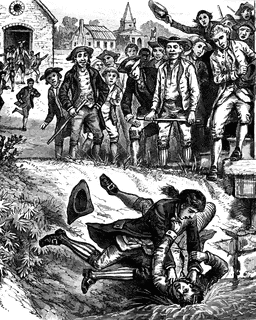
Two men brawl on the ground while others cheer them on.
That autumn, mobs of farmers in Massachusetts under the leadership of a former army captain, Daniel Shays, began forcibly to prevent the county courts from sitting and passing further judgments for debt, pending the next state election. In January 1787 a ragtag army of 1,200 farmers moved toward the federal arsenal at Springfield. The rebels, armed chiefly with staves and pitchforks, were repulsed by a small state militia force; General Benjamin Lincoln then arrived with reinforcements from Boston and routed the remaining Shaysites, whose leader escaped to Vermont. The government captured 14 rebels and sentenced them to death, but ultimately pardoned some and let the others off with short prison terms. After the defeat of the rebellion, a newly elected legislature, whose majority sympathized with the rebels, met some of their demands for debt relief.
THE PROBLEM OF EXPANSION
With the end of the Revolution, the United States again had to face the old unsolved Western question, the problem of expansion, with its complications of land, fur trade, Indians, settlement, and local government. Lured by the richest land yet found in the country, pioneers poured over the Appalachian Mountains and beyond. By 1775 the far-flung outposts scattered along the waterways had tens of thousands of settlers. Separated by mountain ranges and hundreds of kilometers from the centers of political authority in the East, the inhabitants established their own governments. Settlers from all the Tidewater states pressed on into the fertile river valleys, hardwood forests, and rolling prairies of the interior. By 1790 the population of the trans-Appalachian region numbered well over 120,000.
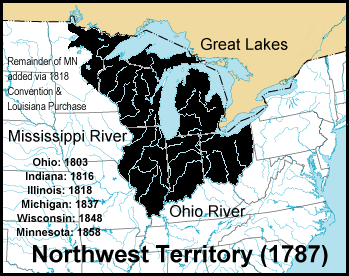
Map of Northwest Territory of 1787
Northwest Ordinance
Before the war, several colonies had laid extensive and often overlapping claims to land beyond the Appalachians. To those without such claims this rich territorial prize seemed unfairly apportioned. Maryland, speaking for the latter group, introduced a resolution that the western lands be considered common property to be parceled by the Congress into free and independent governments. This idea was not received enthusiastically. Nonetheless, in 1780 New York led the way by ceding its claims. In 1784 Virginia, which held the grandest claims, relinquished all land north of the Ohio River. Other states ceded their claims, and it became apparent that Congress would come into possession of all the lands north of the Ohio River and west of the Allegheny Mountains. This common possession of millions of acres was the most tangible evidence yet of nationality and unity, and gave a certain substance to the idea of national sovereignty. At the same time, these vast territories were a problem that required solution
The Confederation Congress established a system of limited self-government for this new national Northwest Territory. The Northwest Ordinance of 1787 provided for its organization, initially as a single district, ruled by a governor and judges appointed by the Congress. When this territory had 5,000 free male inhabitants of voting age, it was to be entitled to a legislature of two chambers, itself electing the lower house. In addition, it could at that time send a nonvoting delegate to Congress. Three to five states would be formed as the territory was settled. Whenever any one of them had 60,000 free inhabitants, it was allowed to draft a state constitution to be submitted to the Congress to be considered for admission to the Union “on an equal footing with the original states in all respects.” The ordinance guaranteed civil rights and liberties, encouraged education, and prohibited slavery or other forms of involuntary servitude.
The new policy repudiated the time-honored concept that colonies existed for the benefit of the mother country, were politically subordinate, and peopled by social inferiors. Instead, it established the principle that colonies (“territories”) were an extension of the nation and entitled, not as a privilege but as a right, to all the benefits of equality with the 13 original states.
CONSTITUTIONAL CONVENTION
By the time the Northwest Ordinance was enacted, American leaders were in the midst of drafting a new and stronger constitution to replace the Articles of Confederation. Shay’s Rebellion had been misrepresented to George Washington as an unwarranted “mob action,” so he quickly decided that the internal and external threats to the new nation were so great, and the entire project in such immediate danger of failure, that he would throw his considerable influence behind a proposal to hold a constitutional convention in Philadelphia in 1787. As their presiding officer, Washington, had written accurately that the states were united only by a “rope of sand.” Disputes between Maryland and Virginia over navigation on the Potomac River had led to a conference of representatives of five states at Annapolis, Maryland, in 1786. One of the delegates, Alexander Hamilton of New York, convinced his colleagues that commerce was bound up with large political and economic questions. What was required was a fundamental rethinking of the entire Confederation of the states.
The Annapolis conference issued a call for all the states to appoint representatives to a convention to be held the following spring in Philadelphia. The Continental Congress was at first indignant over this bold step, but it acquiesced after Washington gave the project his backing and was elected a delegate. During the next fall and winter, elections were held in all states but Rhode Island.
The delegates knew that the national government under the Articles of Confederation was powerless and in need of serious revising—possibly more. Legitimacy was lent to the convention by the presence of Ben Franklin (a nominal Northerner and beloved American) and George Washington (the southern hero of the revolution). Absent from the Convention were Thomas Jefferson, who was serving as minister representing the United States in France, and John Adams, serving in the same capacity in Great Britain. At issue was whether the Articles would be amended to make the central government stronger, or thrown out entirely and replaced with a new constitution. The former was unlikely, due to the unanimous vote required for amendment, the latter was (legally) impossible as the Articles held no provision for their own dissolution.
Also prominent among the more active members were two Pennsylvanians: Gouverneur Morris, who clearly saw the need for national government, and James Wilson, who labored indefatigably for the national idea. From Virginia came James Madison, a practical young statesman, a thorough student of politics and history, and, according to a colleague, “from a spirit of industry and application … the best-informed man on any point in debate.” Madison actually brought with him what would become the working draft (the Virginia Plan) of the Constitution. He would be recognized as the “Father of the Constitution.”
Massachusetts sent Rufus King and Elbridge Gerry, young men of ability and experience. Roger Sherman, shoemaker turned judge, was one of the representatives from Connecticut. From New York came Alexander Hamilton, who had proposed the meeting. Youth predominated among the 55 delegates — the average age was 42.
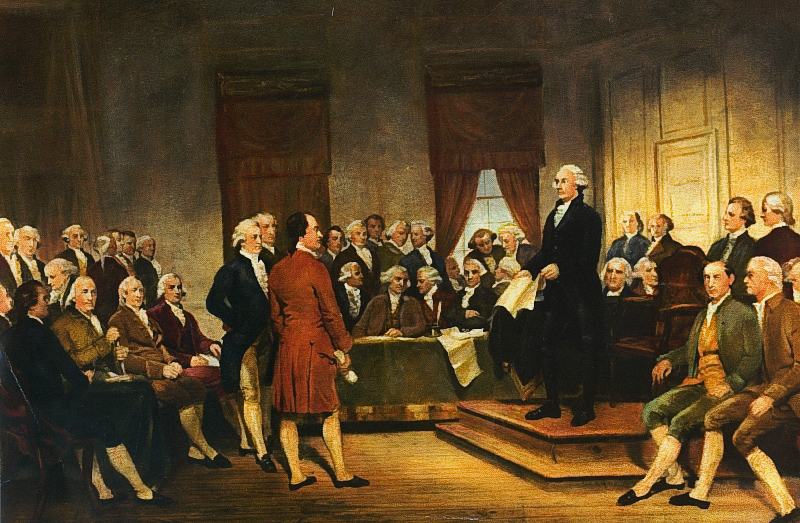
Alexander Hamilton stands on a riser speaking to a group of men.
Video (00:03:09) Constitutional Convention (https://login.proxy.nmc.edu/login?url=http://digital.films.com/play/BSUUCQ) This video is accessible to NMC students only (login required).
Congress had authorized the Convention merely to draft amendments to the Articles of Confederation but, as Madison later wrote, the delegates, “with a manly confidence in their country,” simply threw the Articles aside and went ahead with the building of a wholly new form of government.
They recognized that the paramount need was to reconcile two different powers — the power of local control, which was already being exercised by the 13 semi-independent states, and the power of a central government. They adopted the principle that the functions and powers of the national government — being new, general, and inclusive — had to be carefully defined and stated, while all other functions and powers were to be understood as belonging to the states. But realizing that the central government had to have real power, the delegates also generally accepted the fact that the government should be authorized, among other things, to coin money, to regulate commerce, to declare war, and to make peace.
DEBATE AND COMPROMISE
The 18th-century statesmen who met in Philadelphia were adherents of Montesquieu’s concept of the balance of power in politics. This principle was supported by colonial experience and strengthened by the writings of John Locke, with which most of the delegates were familiar. These influences led to the conviction that three equal and coordinate branches of government should be established. Legislative, executive, and judicial powers were to be so harmoniously balanced that no one could ever gain control. The delegates agreed that the legislative branch, like the colonial legislatures and the British Parliament, should consist of two houses.
Large States vs. Small
On these points there was unanimity within the assembly. But sharp differences also arose. Representatives of the small states — New Jersey, for instance — objected to changes that would reduce their influence in the national government by basing representation upon population rather than upon statehood, as was the case under the Articles of Confederation.
On the other hand, representatives of large states, like Virginia, argued for proportionate representation. This debate threatened to go on endlessly until Roger Sherman came forward with arguments for representation in proportion to the population of the states in one house of Congress, the House of Representatives, and equal representation in the other, the Senate.
Three-fifths Compromise
The alignment of large against small states then dissolved. But almost every succeeding question raised new divisions, to be resolved only by new compromises. Northerners wanted slaves counted when determining each state’s tax share, but not in determining the number of seats a state would have in the House of Representatives. Under a compromise reached with little dissent, tax levies and House membership would be apportioned according to the number of free inhabitants plus three-fifths of the slaves.
Certain members, such as Sherman and Elbridge Gerry, still smarting from Shays’s Rebellion, feared that the mass of people lacked sufficient wisdom to govern themselves and thus wished no branch of the federal government to be elected directly by the people. Others thought the national government should be given as broad a popular base as possible. Some delegates wished to exclude the growing West from the opportunity of statehood; others championed the equality principle established in the Northwest Ordinance of 1787.
There was no serious difference on such national economic questions as paper money, laws concerning contract obligations, or the role of women, who were excluded from politics. But there was a need for balancing sectional economic interests; for settling arguments as to the powers, term, and selection of the chief executive; and for solving problems involving the tenure of judges and the kind of courts to be established.
The Final Product
Laboring through a hot Philadelphia summer, the convention finally achieved a draft incorporating in a brief document the organization of the most complex government yet devised, one that would be supreme within a clearly defined and limited sphere. It would have full power to levy taxes, borrow money, establish uniform duties and excise taxes, coin money, regulate interstate commerce, fix weights and measures, grant patents and copyrights, set up post offices, and build post roads. It also was authorized to raise and maintain an army and navy, manage Native American affairs, conduct foreign policy, and wage war. It could pass laws for naturalizing foreigners and controlling public lands; it could admit new states on a basis of absolute equality with the old. The power to pass all necessary and proper laws for executing these clearly defined powers rendered the federal government able to meet the needs of later generations and of a greatly expanded body politic.
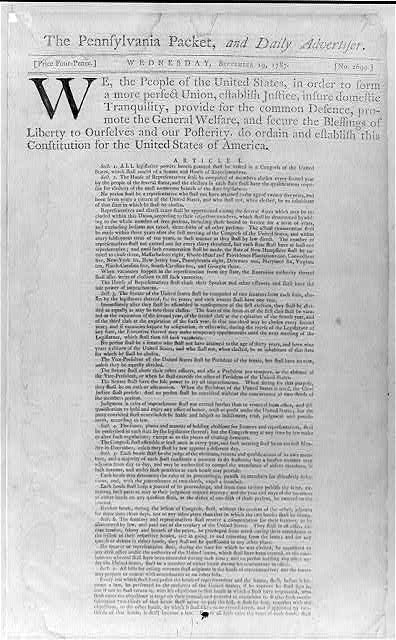
Newspaper articles and notices printed in 1787 during the Constitutional
The principle of separation of powers had already been given a fair trial in most state constitutions and had proved sound. Accordingly, the convention set up a governmental system with separate legislative, executive, and judiciary branches, each checked by the others. Thus congressional enactments were not to become law until approved by the president. And the president was to submit the most important of his appointments and all his treaties to the Senate for confirmation. The president, in turn, could be impeached and, if convicted, removed by Congress. The judiciary was to hear all cases arising under federal laws and the Constitution; in effect, the courts were empowered to interpret both the fundamental and the statute law. But members of the judiciary, appointed by the president and confirmed by the Senate, could also be impeached by Congress.
To protect the Constitution from hasty alteration, Article V stipulated that amendments to the Constitution be proposed either by two-thirds of both houses of Congress or by two-thirds of the states, meeting in convention. The proposals were to be ratified by one of two methods: either by the legislatures of three-fourths of the states, or by convention in three-fourths of the states, with the Congress proposing the method to be used.
Finally, the convention faced the most important problem of all: How should the powers given to the new government be enforced? Under the Articles of Confederation, the national government had possessed — on paper — significant powers, which, in practice, had come to naught, for the states paid no attention to them. What was to save the new government from the same fate?
At the outset, most delegates furnished a single answer — the use of force. But it was quickly seen that the application of force upon the states would destroy the Union. The decision was that the government should not act upon the states but upon the people within the states, and should legislate for and upon all the individual residents of the country. As the keystone of the Constitution, the convention adopted two brief but highly significant statements:
Congress shall have power ...to make all Laws which shall be necessary and proper for carrying into Execution the ... Powers vested by this Constitution in the Government of the United States. ... (Article I, Section 7)
This Constitution, and the Laws of the United States which shall be made in Pursuance thereof; and all Treaties made, or which shall be made, under the Authority of the United States, shall be the supreme Law of the Land; and the Judges in every State shall be bound thereby, any Thing in the Constitution or Laws of any State to the Contrary notwithstanding. (Article VI)
Thus the laws of the United States became enforceable in its own national courts, through its own judges and marshals, as well as in the state courts through the state judges and state law officers.
Debate continues to this day about the motives of those who wrote the Constitution. In 1913 historian Charles Beard, in An Economic Interpretation of the Constitution, argued that the Founding Fathers represented emerging commercial-capitalist interests that needed a strong national government. He also believed many may have been motivated by personal holdings of large amounts of depreciated government securities. However, James Madison, principal drafter of the Constitution, held no bonds and was a Virginia planter. Conversely, some opponents of the Constitution owned large amounts of bonds and securities. Economic interests influenced the course of the debate, but so did state, sectional, and ideological interests. Equally important was the idealism of the framers. Products of the Enlightenment, the Founding Fathers designed a government that they believed would promote individual liberty and public virtue. The ideals embodied in the U.S. Constitution remain an essential element of the American national identity.
RATIFICATION
Video (00:04:24) Ratification (https://login.proxy.nmc.edu/login?url=http://digital.films.com/play/NANTPS) This video is accessible to NMC students only (login required).
On September 17, 1787, after 16 weeks of deliberation, the finished Constitution was signed by 39 of the 42 delegates present. Franklin, pointing to the half-sun painted in brilliant gold on the back of Washington’s chair, said:
I have often in the course of the session ... looked at that [chair] behind the president, without being able to tell whether it was rising or setting; but now, at length, I have the happiness to know that it is a rising, and not a setting, sun.
Special State Conventions
The convention was over; the members “adjourned to the City Tavern, dined together, and took a cordial leave of each other.” Yet a crucial part of the struggle for a more perfect union remained to be faced. The consent of popularly elected special state conventions was still required before the document could become effective. The reason that special state conventions were called for in the ratification process proved both simple and ingenious. Since there was no provision in the Articles of Confederation for its own dissolution, it was thought better to go directly to the people to ascertain their will, rather than using each state’s existing governments. Accordingly, the people of each state elected representatives to attend the special conventions; these special conventions would then (if the Constitution were adopted) impose the Constitution on their respective state governments.
The convention had decided that the Constitution would take effect upon ratification by conventions in nine of the 13 states. By June 1788 the required nine states had ratified the Constitution, but the large states of Virginia and New York had not. Most people felt that without the support of these two states, the Constitution would never be honored. To many, the document seemed full of dangers: Would not the strong central government that it established tyrannize them, oppress them with heavy taxes, and drag them into wars?
Two new Parties
Differing views on these questions brought into existence two parties, the Federalists, who favored a strong central government, and the Antifederalists, who preferred a loose association of separate states -essentially a return to the Articles of Confederation. Impassioned arguments on both sides were voiced by the press, the legislatures, and the state conventions. In fact, because many of the anti-federalists had boycotted the convention rather than see the Articles of Confederation thrown out, their voice was not heard and a decidedly federalist document had resulted.
In Virginia, the Anti-federalists attacked the proposed new government by challenging the opening phrase of the Constitution: “We the People of the United States.” Without using the individual state names in the Constitution, the delegates argued, the states would not retain their separate rights or powers. Virginia Anti-federalists were led by Patrick Henry, who became the chief spokesman for back-country farmers who feared the powers of the new central government. Wavering delegates were persuaded by a proposal that the Virginia convention recommend a bill of rights, and Anti-federalists joined with the Federalists to ratify the Constitution on June 25.
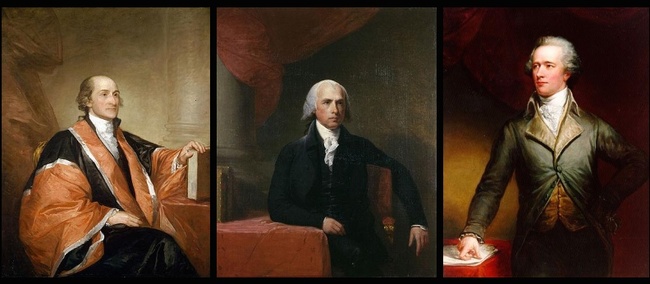
The Federalist Papers
In New York, Alexander Hamilton, John Jay, and James Madison pushed for the ratification of the Constitution in a series of essays known as The Federalist Papers. The essays, published in New York newspapers, provided a now-classic argument for a central federal government, with separate executive, legislative, and judicial branches that checked and balanced one another. With The Federalist Papers influencing the New York delegates, the Constitution was ratified on July 26.
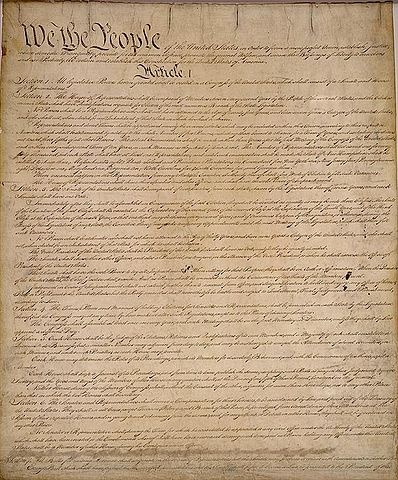
Bill of Rights
Antipathy toward a strong central government was only one concern among those opposed to the Constitution; of equal concern to many was the fear that the Constitution did not protect individual rights and freedoms sufficiently. Virginian George Mason, author of Virginia’s Declaration of Rights of 1776, was one of three delegates to the Constitutional Convention who had refused to sign the final document because it did not enumerate individual rights. Together with Patrick Henry, he campaigned vigorously against ratification of the Constitution by Virginia. Indeed, five states, including Massachusetts, ratified the Constitution on the condition that such amendments be added immediately.
When the first Congress convened in New York City in September 1789, the calls for amendments protecting individual rights were virtually unanimous. Congress quickly adopted 12 such amendments; by December 1791, enough states had ratified 10 amendments to make them part of the Constitution. Collectively, they are known as the Bill of Rights. Among their provisions: freedom of speech, press, religion, and the right to assemble peacefully, protest, and demand changes (First Amendment); right to bear arms (Second Amendment); protection against unreasonable searches, seizures of property, and arrest (Fourth Amendment); due process of law in all criminal cases (Fifth Amendment); right to a fair and speedy trial (Sixth Amendment); protection against cruel and unusual punishment (Eighth Amendment); and provision that the people retain additional rights not listed in the Constitution (Ninth Amendment).
Since the adoption of the Bill of Rights, only 17 more amendments have been added to the Constitution. Although a number of the subsequent amendments revised the federal government’s structure and operations, most followed the precedent established by the Bill of Rights and expanded individual rights and freedoms.
PRESIDENT WASHINGTON
![By Gilbert Stuart (Own work) [Public domain], via Wikimedia Commons](https://www.oercommons.org/editor/images/7665)
Portrait of President George Washington
Video: (00:03:10) The Presidents Washington (https://login.proxy.nmc.edu/login?url=http://fod.infobase.com/p_ViewPlaylist.aspx?AssignmentID=CKJHDY) This video is accessible to NMC students only (login required).
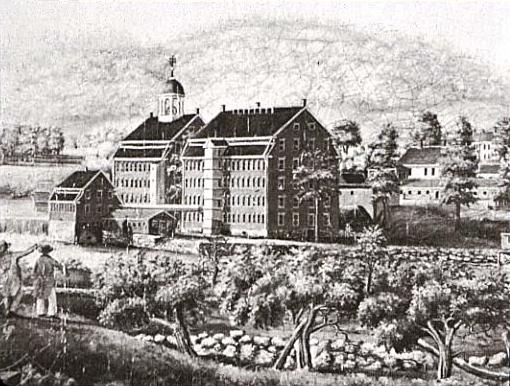
One of the last acts of the Congress of the Confederation was to arrange for the first presidential election, setting March 4, 1789, as the date that the new government would come into being. One name was on everyone’s lips for the new chief of state, George Washington. He was unanimously chosen president and took the oath of office at his inauguration on April 30, 1789. In words spoken by every president since, Washington pledged to execute the duties of the presidency faithfully and, to the best of his ability, to “preserve, protect, and defend the Constitution of the United States.”
When Washington took office, the new Constitution enjoyed neither tradition nor the full backing of organized public opinion. The new government had to create its own machinery and legislate a system of taxation that would support it. Until a judiciary could be established, laws could not be enforced. The army was small. The navy had ceased to exist.
Congress quickly created the departments of State and Treasury, with Thomas Jefferson and Alexander Hamilton as their respective secretaries. Departments of War and Justice were also created. Since Washington preferred to make decisions only after consulting those men whose judgment he valued, the American presidential Cabinet came into existence, consisting of the heads of all the departments that Congress might create. Simultaneously, Congress provided for a federal judiciary — a Supreme Court, with one chief justice and five associate justices, three circuit courts, and 13 district courts.
Early Growth and Industry
Meanwhile, the country was growing steadily and immigration from Europe was increasing. Americans were moving westward: New Englanders and Pennsylvanians into Ohio; Virginians and Carolinians into Kentucky and Tennessee. Good farms were to be had for small sums; labor was in strong demand. The rich valley stretches of upper New York, Pennsylvania, and Virginia soon became great wheat-growing areas.
Although many items were still homemade, the Industrial Revolution was dawning in the United States. Massachusetts and Rhode Island were laying the foundation of important textile industries; Connecticut was beginning to turn out tinware and clocks; New York, New Jersey, and Pennsylvania were producing paper, glass, and iron. Shipping had grown to such an extent that on the seas the United States was second only to Britain. Even before 1790, American ships were traveling to China to sell furs and bring back tea, spices, and silk.
At this critical juncture in the country’s growth, Washington’s wise leadership was crucial. He organized a national government, developed policies for settlement of territories previously held by Britain and Spain, stabilized the northwestern frontier, and oversaw the admission of three new states: Vermont (1791), Kentucky (1792), and Tennessee (1796). Finally, in his Farewell Address, he warned the nation to “steer clear of permanent alliances with any portion of the foreign world.” This advice influenced American attitudes toward the rest of the world for generations to come.
HAMILTON VS. JEFFERSON
![Alexander Hamilton and Thomas Jefferson by The Bureau of Engraving and Printing (Restoration by Godot13) [Public domain or CC BY-SA 3.0], via Wikimedia Commons](https://www.oercommons.org/editor/images/1354)
Alexander Hamilton and Thomas Jefferson
A conflict took shape in the 1790s between America’s first political parties. Indeed, the Federalists, led by Alexander Hamilton, and the Democratic-Republicans (Formerly the Anti-Federalists), led by Thomas Jefferson, were the first political parties in the Western world. Unlike loose political groupings in the British House of Commons or in the American colonies before the Revolution, both had reasonably consistent and principled platforms, relatively stable popular followings, and continuing organizations.
The Federalists in the main represented the interests of trade and manufacturing, which they saw as forces of progress in the world. They believed these could be advanced only by a strong central government capable of establishing sound public credit and a stable currency. Openly distrustful of the latent radicalism of the masses, they could nonetheless credibly appeal to workers and artisans. Their political stronghold was in the New England states. Seeing England as in many respects an example the United States should try to emulate, they favored good relations with their mother country.
![By George Heap (U.S. National Archives and Records Administration) [Public domain], via Wikimedia Commons; modified (cropped)](https://www.oercommons.org/editor/images/7666)
Many sail boats floating in the port of Philadelphia with the view of the city behind them in 1768
![By M.F. Corne (Historic New England) [Public domain], via Wikimedia Commons](https://www.oercommons.org/editor/images/7667)
Image of man riding a horse and carriage are trotting down historic New England country side.
Although Alexander Hamilton was never able to muster the popular appeal to stand successfully for elective office, he was far and away the Federalists’ main generator of ideology and public policy. He brought to public life a love of efficiency, order, and organization. In response to the call of the House of Representatives for a plan for the “adequate support of public credit,” he laid down and supported principles not only of the public economy, but of effective government. Hamilton pointed out that the United States must have credit for industrial development, commercial activity, and the operations of government, and that its obligations must have the complete faith and support of the people.
There were many who wished to repudiate the former Confederation’s national debt or pay only part of it. Hamilton insisted upon full payment and also upon a plan by which the federal government took over the unpaid debts of the states incurred during the Revolution. He also secured congressional legislation for a Bank of the United States. Modeled after the Bank of England, it acted as the nation’s central financial institution and operated branches in different parts of the country. Hamilton sponsored a national mint, and argued in favor of tariffs, saying that temporary protection of new firms could help foster the development of competitive national industries. These measures — placing the credit of the federal government on a firm foundation and giving it all the revenues it needed — encouraged commerce and industry, and created a solid phalanx of interests firmly behind the national government.
Jefferson’s Vision
The Democratic-Republicans, led by Thomas Jefferson, spoke primarily for agricultural interests and values. They distrusted bankers, cared little for commerce and manufacturing, and believed that freedom and democracy flourished best in a rural society composed of self-sufficient farmers. They felt little need for a strong central government; in fact, they tended to see it as a potential source of oppression. Thus they favored states’ rights. They were strongest in the South and West.
Hamilton’s great aim was more efficient organization, whereas Jefferson once said, “I am not a friend to a very energetic government.” Hamilton feared anarchy and thought in terms of order; Jefferson feared tyranny and thought in terms of freedom. Where Hamilton saw England as an example, Jefferson, who had been minister to France in the early stages of the French Revolution, looked to the overthrow of the French monarchy as vindication of the liberal ideals of the Enlightenment. Against Hamilton’s instinctive conservatism, he projected an eloquent democratic radicalism.
Bank of the United States
![By Library Company of Philadelphia [No restrictions], via Wikimedia Commons](https://www.oercommons.org/editor/images/7668)
The front of the First Bank of America building.
An early clash between them, which occurred shortly after Jefferson took office as secretary of state, led to a new and profoundly important interpretation of the Constitution. Washington was a Federalist but very mindful of the precedents he would set for the new nation. Accordingly, when Alexander Hamilton proposed Congress’ establishment of the Bank of the United States, Washington was careful to hear the Anti-Federalist side argued by his Secretary of State —Thomas Jefferson. Jefferson argued that since no constitutional power was specifically assigned to the Congress to create a bank of the United States, that it was unconstitutional to do so. Hamilton rejoined that it was constitutional because Article I granted Congress the power to make “all laws necessary and proper” to the conduct of the other powers granted Congress. The bank, he argued, was both necessary and proper. Since the Constitution authorized the national government to levy and collect taxes, pay debts, and borrow money, a national bank would materially help in performing these functions efficiently. Congress, therefore, was entitled, under its implied powers, to create such a bank. Washington and the Congress accepted Hamilton’s view — and set an important precedent for an expansive interpretation of the federal government’s authority. Washington signed the bill in 1791.
Hamilton’s Vision
Alexander Hamilton supported the creation of the Bank, in part, as a check on free-wheeling state banks and as a stabilizing influence on the national economy. State banks were prone to lending far more money than they had on deposit; the more they lent, after all, the more interest they received—that is, until a financial panic created a run on the banks; such banks, of course, would not be able to pay everyone off. A national bank could put such banks on notice by buying up their notes. This would serve as a signal that they were too speculative and should stop giving out so many notes. If, for example, the Bank of the United States were to turn in for redemption, a massive amount of notes from a state bank, the state bank would collapse. It worked. Hamilton’s vision was that of a strong, industrial nation with great cities and manufacturing as the backbone of the economy. Hamilton wanted to duplicate England’s success but none of this would be possible without a stable economy and this was the point of the Bank.
THE FRENCH REVOLUTION AND FOREIGN POLICY
![Henry Singleton [Public domain], via Wikimedia Commons](https://www.oercommons.org/editor/images/7669)
Gun smoke fills the air during the Storming of Bastille
Although one of the first tasks of the new government was to strengthen the domestic economy and make the nation financially secure, the United States could not ignore foreign affairs. The cornerstones of Washington’s foreign policy were to preserve peace, to give the country time to recover from its wounds, and to permit the slow work of national integration to continue. Events in Europe threatened these goals.
American Parties Take Sides
Many Americans watched the French Revolution with keen interest and sympathy. The French, staggering under the debt accumulated by helping the Americans with their revolution, engaged in a bloody revolution of their own. Beginning in 1789 with the storming of the hated “Bastille” prison, the revolution spun out of control and, by 1793, the French found themselves at war with a European coalition led by England. In the United States, the Anti-Federalist followers of Thomas Jefferson were greatly encouraged by the Revolution in France. They saw it as the spreading of democracy and sought United States’ support for the Revolution. The Federalists, led by Alexander Hamilton, feared the revolution and its excesses of blood-letting, anti-christian rhetoric, and lack of a coherent doctrine to justify itself. Hamilton even went so far as to propose an alliance with England—against France. Meanwhile a new French envoy, Edmond Charles Genet — Citizen Genet — was coming to the United States.
Video: (00:02:49) The Presidents: Welcome (https://login.proxy.nmc.edu/login?url=http://digital.films.com/play/A5HPWY) This video is accessible to NMC students only (login required).
When Genet arrived, he was cheered by many citizens, but treated with cool formality by the government. Angered, he violated a promise not to outfit a captured British ship as a privateer (privately owned warships commissioned to prey on ships of enemy nations). Genet then threatened to take his cause directly to the American people, over the head of the government. Shortly afterward, the United States requested his recall by the French government.
When the revolution in France led to the execution of King Louis XVI in January 1793, Britain, Spain, and Holland became involved in war with France. According to the Franco-American Treaty of Alliance of 1778, the United States and France were perpetual allies, and the United States was obliged to help France defend the West Indies. However, the United States, militarily and economically a very weak country, was in no position to become involved in another war with major European powers.
For his part, Washington feared the revolution as did other Federalists. The sticking point was that an alliance had existed between France and the United States since 1777. Did the new nation not owe something to the nation that helped win its independence? Washington issued a proclamation of neutrality (an act that pleased neither side) and supported the continued repayment of the U.S. monetary debt to France. He justified this by claiming that the government with which the alliance had been penned, no longer existed—indeed that government’s head lay in a basket beneath the gallows.
John Jay’s Treaty
The Genet incident had strained American relations with France at a time when those with Great Britain were far from satisfactory. British troops still occupied forts in the West, property carried off by British soldiers during the Revolution had not been restored or paid for, and the British Navy was seizing American ships bound for French ports. The two countries seemed to be drifting toward war. Washington sent John Jay, first chief justice of the Supreme Court, to London as a special envoy. Jay negotiated a treaty that secured (on paper) withdrawal of British soldiers from western forts but allowed the British to continue the fur trade with the Indians in the Northwest. London agreed to pay damages for American ships and cargoes seized in 1793 and 1794, but made no commitments on possible future seizures. Moreover, the treaty failed to address the festering issue of British “impressment” of American sailors into the Royal Navy, placed severe limitations on American trade with the West Indies, and accepted the British view that food and naval stores, as well as war materiel, were contraband subject to seizure if bound for enemy ports on neutral ships.
American diplomat Charles Pinckney was more successful in dealing with Spain. In 1795, he negotiated an important treaty settling the Florida border on American terms and giving Americans access to the port of New Orleans. All the same, the Jay Treaty with the British reflected a continuing American weakness in relation to a world superpower. Deeply unpopular, it was vocally supported only by Federalists who valued cultural and economic ties with Britain. Washington backed it as the best bargain available, and, after a heated debate, the Senate approved it.
Citizen Genet’s antics and Jay’s Treaty demonstrated both the difficulties faced by a small, weak nation caught between two great powers and the wide gap in outlook between Federalists and Republicans. To the Federalists, Republican backers of the increasingly violent and radical French Revolution were dangerous radicals (“Jacobins”); to the Republicans, advocates of friendship with England were monarchists who would subvert the natural rights of Americans. The Federalists connected virtue and national development with commerce; the Republicans saw America’s destiny as that of a vast agrarian republic. The politics of their conflicting positions became increasingly vehement.
Ultimately the French Revolution would fail because it was too revolutionary. Whereas the United States had remade the parliamentary system to its own liking, the French Revolution had abolished the monarchy entirely, confiscated church property (thereby alienating most of the population), established new names for the months of the year as well as a ten day week, and proclaimed an atheist (or nominally deist) government. By 1799, the French Republic was bankrupt and susceptible to a military coup. In November, the military hero, Napoleon Bonaparte, took control of the government.
Video: (00:02:50) The Presidents (Adams) (https://login.proxy.nmc.edu/login?url=http://digital.films.com/play/MKUBNH) This video is accessible to NMC students only (login required).
ADAMS AND JEFFERSON
Washington retired in 1797, firmly declining to serve for more than eight years as the nation’s Chief Executive. Thomas Jefferson of Virginia (Democratic-Republican) and John Adams (Federalist) vied to succeed him. Adams won a narrow election victory. From the beginning, however, he was at the head of a party and an administration divided between his Federalist backers and those of his Federalist rival, Hamilton.
Adams faced serious international difficulties. France, angered by Jay’s treaty with Britain, adopted Britain’s definition of contraband and began to seize American ships that were headed there. By 1797 France had snatched 300 American ships and broken off diplomatic relations with the United States. Unhappy with Washington’s position on neutrality, the French were sacking American shipping in the sugar islands and, as the “quasi-war” heated up, along the eastern seaboard of the United States. John Adams supported, and the Congress authorized, the building of a navy to protect American interests.
![Capture of the French Privateer Sandwich by armed Marines on the Sloop Sally, from the U.S. Frigate Constitution, By Philip Colprit [Public domain or FAL], via Wikimedia Commons](https://www.oercommons.org/editor/images/1355)
“XYZ Affair”
As the quasi war escalated, anti-French sentiment grew and the Democratic Republicans began to lose support (they had supported the revolutionary government of France). John Adams, in a move that was unpopular with his Federalist allies, sent commissioners to France to seek terms of peace in 1797. When the three men of the French delegation (listed in the official report as “x,” “y,” and “z”) demanded a bribe from the Americans to begin negotiations, the American public became outraged and turned squarely against the French. The Democratic Republicans now looked like traitors for their prior support of the French and their revolution; they lost countless elections to the Federalist opposition in 1798.
In 1799, after a series of sea battles with the French, all-out war seemed inevitable. In this crisis, Adams rejected the guidance of Hamilton, who wanted war, and reopened negotiations with France. Napoleon, who had just come to power, received them cordially. The danger of conflict subsided with the negotiation of the Convention of 1800, which formally released the United States from its 1778 defense alliance with France. However, reflecting American weakness, France refused to pay $20 million in compensation for American ships taken by the French Navy.
Alien and Sedition Acts
Hostility to France had led the Federalist-dominated Congress to pass the Alien and Sedition Acts, which had severe repercussions for American civil liberties. The Naturalization Act, which changed the requirement for citizenship from five to 14 years, was targeted at Irish and French immigrants suspected of supporting the Democratic-Republicans. The Alien Act, operative for two years only, gave the president the power to expel or imprison aliens in time of war. The Sedition Act proscribed writing, speaking, or publishing anything of “a false, scandalous, and malicious” nature against the president or Congress. Predictably, the Federalists used these acts to imprison and otherwise oppress the Democratic-Republicans. The few convictions won under it created martyrs to the cause of civil liberties and aroused new support for the Republicans.
Virginia and Kentucky Resolutions
This obvious violation of the Constitution would lead Virginia and Kentucky to immediately pass resolutions claiming that the states were the ultimate judges of the constitutionality of federal laws and actions. As such, they could declare “null and void” any such unconstitutional acts of the federal government. While these resolutions were themselves unconstitutional, Jefferson and Madison who penned them, had been backed into a corner by a Federalist-dominated Congress and had no place to turn. Ultimately, secession, they reasoned, might need to be employed to resolve such crises. The Doctrine of Nullification would be used later by the Southern states’ resistance to protective tariffs, and, more ominously, the abolition of slavery.
____________________________________________